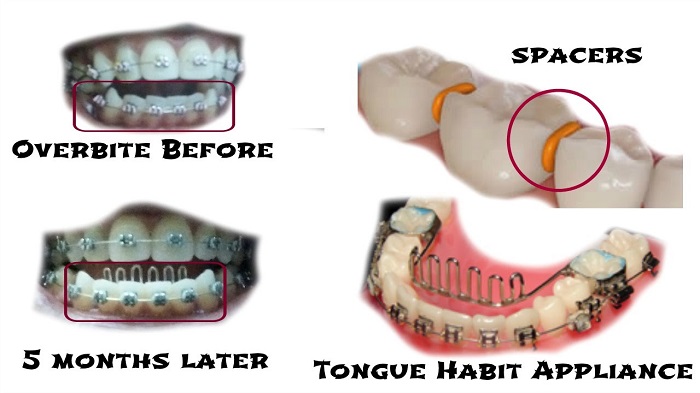Most people would love to have straight teeth and a gorgeous smile. When you have overbite teeth, however, it’s more than a cosmetic issue. An overbite can cause alignment problems and uneven wear. If combined with crooked or closely spaced teeth, it may increase the risk of tooth decay and gum disease. Overbites occur for a number of different reasons. However, several effective treatments are available. Here’s what you need to know about overbites.
What Is an Overbite?
When your teeth are properly aligned, the top teeth will be slightly forward of the lower teeth when your mouth is closed. This allows the molars (back teeth) to meet properly and provides an adequate chewing surface. Although this is technically an overbite, it is a normal condition and doesn’t cause problems.
Malocclusion occurs when the top teeth are too far forward or too far back, leaving a gap between the vertical surfaces of the teeth. When the upper teeth are too far back, the condition is known as an underbite, and when the top teeth are too far forward, the condition is known as an overbite.
Malocclusions are classified into three categories:
- Class One is the normal slight overlap of the upper front teeth.
- A Class Two overbite, called a retrognathic overbite, occurs when the overbite is severe.
- A severe underbite, however, is known as a prognathic underbite.
Serious overbites and underbites usually need treatment. Other types of malocclusions are the crossbite, in which one or more teeth are too close to either the cheek or gum, and an open bite, where the upper and lower teeth don’t meet even when the jaw is closed.
Why Do Overbites Matter?
Whether an overbite matters is dependent on a number of factors. From an aesthetic point of view, overbites are not as attractive to most people as properly aligned teeth. A severe overbite can interfere with your ability to bite or chew your food properly.
Overbites are often accompanied by other dental problems, such as crowded or widely spaced teeth. Both of these conditions can increase the risk of tooth decay and dental disease, because they trap food particles and make teeth harder to clean.
An overbite can cause strain on the jaw muscles and contribute to jaw pain or headaches. Misaligned teeth are often more susceptible to chips, cracks and breakage because the pressure of chewing is uneven. An overbite can also contribute to uneven tooth wear. Finally, overbites can make people feel self-conscious and may have a negative effect on self-esteem. This is particularly true for children or even adults who are teased by their peers.
What Causes an Overbite?
The most important factor in whether you have an overbite is your genetic heritage. Overbites typically run in families. Genetics affect the shape and growth rate of the jaw. The most common genetic problem relevant to an overbite is that the lower jaw is underdeveloped. However, sometimes the upper jaw is too developed and sticks out past the lower jaw. In either case, the result is an overbite.
Many children develop habits that can lead to an overbite. These include thumb-sucking, extensive use of a pacifier, prolonged bottle feeding (beyond the age of three years) and tongue thrusting. Habits that carry over into adulthood, such as nail biting or chewing on pencil heads and other hard objects, can also contribute to overbite teeth.
Sometimes what people describe as an overbite is really related to the position of the teeth rather than the jaw. Buck teeth, for example, may be described as an overbite because the upper teeth stick out, but the jaw itself is actually in a normal position.
Overbite Teeth Treatment
Treatment of an overbite depends on the actual problem, how severe it is and whether there are other issues such as tightly spaced, crooked teeth. In all cases, treatment begins with a careful assessment of the teeth, mouth and jaw, a review of your dental history that includes such factors as habits like tongue sucking, X-rays and impressions of the teeth.
The impressions are used both to help assess the condition and to develop a treatment plan. Today, many dentists use computer-generated images in their treatment planning, which helps the patient/parent see what the mouth and teeth will look like when treatment is concluded.
Overbite Treatment Methods
- Orthodontia – modern orthodontics allows for several different kinds of braces. These include traditional metal braces, ceramic braces, lingual braces, adjustable braces and plastic aligners that fit over the teeth, such as the Invisalign system. Of these traditional metal braces are the least expensive and can be used for all orthodontic conditions. However, lingual braces (fitted on the inside of the teeth) are less visible. The Invisalign aligner is removable, which makes oral hygiene easier and does not require dietary modifications.
- Dental Appliances – in addition to orthodontia, different kinds of dental appliances may also be used to treat overbite teeth. Headgear can correct an overbite but it focuses on the upper jaw; overbite problems are more likely to be related to the lower jaw. Removable retainers or elastics attached to braces can move the lower jaw forward and encourage it to grow. A spring inside the mouth and cheeks can also help guide jaw growth for severe cases.
- Extractions and Surgery – Overbites don’t usually exist in a vacuum – teeth may be crowded, especially if the lower jaw is too small. In that case, one or more teeth may need to be extracted so braces and other treatments can correct the overbite problem. Occasionally, a patient may have such a severe overbite due to an excessively large upper or small lower jaw that surgery is required.
Conclusion
Overbite teeth can cause a number of problems, especially over the long term. However, treatment is possible for both children and adults; consult a qualified orthodontist. Have you had treatment for overbite teeth? Please comment on your experiences.


Leave a Comment